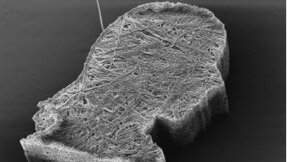
Ultrashort laser pulses, with a duration of a few picoseconds or below offer superior quality and precision for the generation of micron size features. This technique is suitable for structuring a large variety of materials, ranging from metals to polymers, glasses, crystals, and ceramics. It acts as an enabling technology for micromachining of components and tools in electronics, optics and precision engineering. Due to the extremely short pulse duration, only electrons are heated at first. Energy transfer to the lattice takes place on a timescale longer than the pulse itself (Fig. 1). Heat conduction is limited and a superheated layer of the size of the irradiated volume is generated. This finally leads to ablation within a well-defined region with minimized thermal and mechanical damage to the surrounding [Appl. Phys. A 63, 109-115 (1996)External link].
In contrast, longer pulses, e.g. nanosecond pulses, continuously heat the material during the pulse duration. Heat conduction spreads the pulse energy to an area much larger than the original focus spot. The material starts boiling and evaporates, leaving behind a significant melt layer. In addition, the heat transfer to the material prevents the structuring of very thin or sensitive substances, which however is no problem for ultrashort laser pulses (Fig. 2).
Fig. 2: In contrast to "long" pulses, ultrashort pulses enable high precision machining with limited heat affection in metals (left) and even for sensitive materials (right).
Image: Univ. Jena, IAPSelected research topics:
- laser material interaction
- surface structuring and modification
- thin film processing, e.g. for photovoltaic applications
- deep machining, e.g. drilling of micron size holes with high aspect ratio
